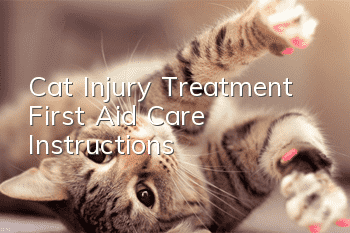Cat Injury Treatment First Aid Care Instructions

Cats are born adventurers, and they are very vulnerable to injuries in daily life, not to mention when they are in estrus. They will be scarred because of jealousy and fights. Pet owners always feel distressed when they see their beloved cats covered in scars. It is necessary to prepare some special medicines and learn how to deal with these injuries.
1. Three common trauma factors in cats
1. Estrus causes conflict
During the estrus period, they get jealous and fight. During estrus, many cats, especially male cats, become more irritable and can easily conflict with other cats.
2. Cats compete for food
Cats fighting each other for food can easily cause collective fights, and this situation often occurs in cats who often go out. Therefore, special attention should be paid to cats who are used to going out and hanging out frequently.
3. Accidental stabbing and scratching
Some cats are prone to being stabbed or scratched by sharp objects such as wires when they go out. Cats in particular like to climb high and low, and get into sparsely populated corners, where debris can easily be found.
2. Emergency methods for pet cat trauma
1. Scratching and biting each other and getting hurt
When a cat fights or comes back from the outside, be sure to check to see if there are any wounds. When a bite is found, it must be disinfected first and then receive veterinary diagnosis and treatment to ensure the health and safety of the cat.
2. The cat was burned by fire
(1) If there are slight burns on the feet, etc., it is most important to wrap the cat with a towel and quickly cool the affected area with running water.
(2) If the head is burned, apply ice to the affected area first, then wrap the affected area with a bandage, then apply ice to the bandage and seek medical attention immediately.
(3) When the whole body is burned, you need to quickly soak the whole body in water, then wrap it with a cold wet towel, and feed lotion diluted with water to prevent dehydration.
Never apply ointment immediately, but first cool the affected area with running water.
3. Bone damage and fracture
(1) If you have a fracture and cannot walk, or if you are dragging your feet, do not touch the affected area casually to avoid damaging nerves or blood vessels.
(2) If the wound is on the back, you can lie on your side on a wooden board and fix it with a rope.
(3) If there is deformation, trauma, or protruding bones, put a towel under the fracture site, then hold it carefully and send it to the doctor for emergency treatment.
When breaking a bone, pay attention to fixing the affected area and do not pull it at will.
4. Stumble, fall and drown
If the cat drowns unexpectedly, you can grab it with both hands.Hold your feet up and hang upside down for ten to twenty seconds, and then swing up and down three to four times to spit out the water that has entered the lungs; when breathing is weak, artificial respiration can be performed.
Because the cat’s body hair is fine and less oily, it cannot eliminate moisture and is most afraid of getting wet.
5. Accidental traffic accident
You can first visually check the condition of the injury. If the bleeding does not stop, you can first find the bleeding location, and then cut off the body hair around the wound. If there are any foreign bodies or glass fragments, they must be removed first, perform simple hemostasis first, and send them to a doctor immediately. .
Sometimes cats may appear to have no trauma, but may develop symptoms such as hematuria or vomiting one or two days later.
6. Eating fish bones can sting your throat
You should use your left thumb and index finger to press behind the canine teeth to open the mouth, pull out the tongue, and use a flashlight to illuminate the inside of the throat, and then carefully remove the foreign object with round tweezers at the front. If you feel it is difficult or cannot figure it out, do not force it. It is better to seek medical attention urgently.
You should pay attention if you find that your cat suddenly stops eating, wipes its mouth with its front feet, or drools in pain.
7. Foreign objects fall into the eyes
Once a foreign object enters the eye, the cat will constantly rub the bloodshot and tearful eyes. The best way is to send the patient to the hospital immediately, where it would be more appropriate for a veterinarian to handle it urgently. To prevent your cat from constantly rubbing its eyes with its front feet, you can wrap the cat's front feet with a bandage.
Using human eye drops to help cats wash away foreign objects will actually make the condition worse.
3. Prepare first aid supplies for cats
1. Daily basic preparation
(1) Medical alcohol: used for disinfection, especially during injections; it can also be used to rub on the foot pads to cool down when you have a fever; or to clean your ears, which can be easily wiped clean with alcohol.
(2) Normal saline: for daily care. Wipe your teeth, wipe the outside of your eyes, wipe your nose, wipe your mouth. It can also be used for rehydration when you are sick.
(3) Glucose: Used to supplement energy when you are sick and skip meals. But feeding too much will affect appetite.
(4) Nutritional paste for cats: better nutritional supplements, very expensive.
(5) Iodine: for parents, to disinfect when scratched or bitten by a cat. Remember: Cats cannot use iodine!
2. Preparation of tools and equipment
(1) Scissors: Used to remove hair around wounds, especially where skin diseases occur. Hair must be cut.
(2) Disposable injection needle: for injecting or feeding medicine. Give water or food when you are sick.
(3) Thermometer: The normal body temperature of cats is about 38.7 degrees.
3. External application of drugs
(1) Erythromycin ointment: antibacterial ointment, used to treat trauma. Apply to minor wounds after cleaning with soap and water.
(2) Chloramphenicol eye drops: used to wash eyes; it can also be used when the eyes are red or there is an increase in eye feces.
(3) Erythromycin eye ointment: It has the same effect as eye drops, but it is longer lasting than eye drops and is good for treating minor inflammation of the eyes.
(4) Ringworm solution for animals: It is very effective in treating ringworm in cats.
When preparing medicines for cats, pet owners must pay attention to one thing, that is, some of the medicines used by cats are exclusive, and medicines used by humans are not allowed. For example, eye drops will cause the cat's condition to worsen.
- How to get rid of fleas on kittens?
- How old can a cat take hair removal cream? How often should cats use hair removal cream?
- Signs that a female cat doesn’t want to take care of her babies
- What vegetables do cats eat?
- What should you pay attention to when raising Burmese cats?
- What should I do if a hard lump bulges in the wound of a female cat after being neutered?
- Pus-like discharge from cat’s eyes
- Cat rubs its head against people and purrs
- Cat eyes bleeding
- Things you must pay attention to when training cats, novices must know!



